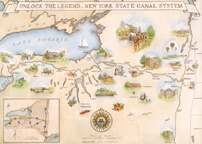
Home | Canal System | Historical Documents | 175th Anniversary
Images | Maps | Tour | Traces | Locks | Boats | Books and Videos | Music | Links




Come explore some of the oldest water routes in North America and follow in the wake of history.
The legend of the grand Erie Canal flows as strongly today as it did when it was opened in 1825. Four waterways -- the Erie, the Champlain, the Oswego, and the Cayuga-Seneca -- travel through New York's heartland, gliding past lush farmland, famous battlefields, scenic port towns, and thriving wildlife preserves.
The 524-mile New York State Canal System connects with hundreds of miles of lakes and rivers across the Empire State, linking the Great Lakes with the majestic Hudson River and with five waterways in Canada.
Along this historic corridor, visitors of all ages can enjoy more than 2,500 recreational facilities and attractions. Pleasure boaters, motorists, hikers, and bicyclists alike will delight in unlocking the legend of New York's canals.
When Governor DeWitt Clinton first proposed a Canal from the Hudson River to the Great Lakes, detractors dismissed the project as "Clinton's folly." The Erie Canal took seven years to build and was the engineering marvel of its day -- yet it was constructed without the aid of a single professional engineer. It cut through 363 miles of wilderness and featured 18 aqueducts and 83 locks, with a rise of 568 feet from the Hudson River to Lake Erie.
Finished in 1825, it spurred the first great westward migration of American settlers, opened the only trade route west of the Appalachians, and help make New York the preeminent commercial city in the U.S. The Erie Canal was enlarged three times to accommodate heavy traffic, most recently between 1905 and 1918 when the present-day Canal system was configured.
Today the canals use or run parallel to the original waterways. And although the focus has shifted from commerce to pleasure, much of the equipment that allows thousands of recreational boaters to "lock through" the system's 57 locks every year dates back to 1918 and is meticulously maintained, often by second and third generation locktenders.
The world has changed since 1825, but along the canals the pace today is just as leisurely, the hospitality just as neighborly for contemporary travelers (as apt to come by car, bicycle, on foot, or by boat) as in the days of mule drawn packet boats and "hoggee" mule drivers.
Nearly every major city in New York can be found along the trade route established by the Erie Canal: it links Buffalo, Rochester, Syracuse, Utica, and Albany with New York City. So canal life beckons from the doorstep of every New York metropolitan center.
And the Canal system threads through five of the state's vacation regions each with a host of unique attractions. Scores of parks, picnic areas, restaurants, inns, museums, and historic sites are strung like small jewels along the canal's banks with even more to explore inland. Visit during summer and enjoy one of many Canal festivals held in dozens of towns.
A trip along the canal is a voyage into history. This rich heritage comes alive in many settings. Experience canal traditions at the Erie Canal Museum in Syracuse, the Canal Town Museum in Canastota, and Erie Canal Village in Rome -- a complete, restored 1840s canal village. Ride in a mule-drawn packet boat near Medina, or visit Lockport to see locks from the 1840s Canal.
Or explore vestiges of abandoned canal sections, preserved stone locks, and grassy towpaths once trodden by mule teams and now restored for hikers and bicyclists in canalside parks. Old lock 52 is adjacent to the New York State Thruway.
To truly appreciate New York's Canals you can't be a landlubber. From May through November, it's on a boat that the canals truly come alive.
Use your own boat or rent a fully equipped canal boat, and chart your own course. Marinas provide a full range of services for transient boaters. You can tie up and explore quiet, 19th-century canal towns, bicycle to nearby wineries for a tour, then dine aboard as the sun gently sets.
Tour boats also operate on all the Canal System's waterways. Cruise for a few hours or a few days, stopping at quaint inns and waterside restaurants along the way.
Vessels up to 300 feet long and 40 feet wide and pleasure craft can meander the length of the system -- but bridges limit overhead clearance to 15 1/2 or 20 feet.
See life from a different perspective. A solitary blue heron resting at the Montezuma National Wildlife Refuge in Seneca Falls. Flocks of geese rising above the Champlain Canal. The Adirondacks boldly outlined against the sky at dusk. These, and thousands of other memories, are waiting for you. What you'll see and remember is up to you.
http://www.eriecanal.org/system.html